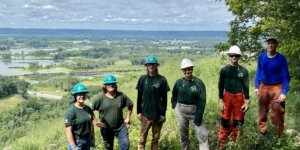Friends of the Blufflands dedicated to preservation
June 8, 2024
| By La Crosse Community Foundation |
Fostering a life-supporting ecosystem

Friends of the Blufflands’ Mike O’Brien (far right) works with a WisCorps crew on Mathy Bluff Prairie. FBL works with numerous volunteers and other community organizations to accomplish its mission.
Committed to preservation, Friends of the Blufflands has significantly affected the greater La Crosse area. Through forest management, prairie restoration, and the careful handling of native species, the grassroots nonprofit organization is working to protect and foster a local ecosystem that supports both wildlife and community life.
Mike O’Brien is a board member and an avid volunteer in the group. His enthusiasm for the bluff lands seals his commitment while also inspiring others to join the cause. You can see it through the organization’s many successful initiatives to rehabilitate and preserve large swathes of natural land, enhancing local biodiversity and community engagement.
Of course, the role of social capital cannot be overstated in these conservation efforts. By rallying a network of volunteers, local students, and partnering organizations, Friends of the Blufflands cultivates a collective investment in the environment. This shared commitment not only multiplies the physical labor available for such large-scale conservation projects but also strengthens communal ties.
What are some key conservation projects Friends of the Blufflands has undertaken?
FBL has spearheaded efforts to preserve and restore approximately 140 acres of the prairies and woodlands of the bluff land parks and Hixon Forest over the past several years. These prairies are Ice Age relics that are thousands of years old. We have removed invasive species and restarted much-needed prescribed burning of the remaining bluff prairies that border La Crosse. We have started reforestation on the edges of Hixon Forest, restoring savanna areas in the forest and replanting woodland wildflowers.
All these projects provide habitat for a multitude of animals, birds, and insects, including the federally endangered rusty patched bumblebee, and thus enhance the enjoyment of these parks for all visitors. Without this work, we might lose these prairies forever as forests and invasive species overtake them. As they disappear, all the plants and animals that live there and use them may be lost as well. We would lose the precious pollinators we need for many of our crops, and we would lose the scientific and aesthetic value of high-quality prairies and woodlands.
What personal connection do you have with bluff lands?
I enjoy working with the Friends of the Blufflands as it provides an opportunity to help restore the amazing natural areas we have around La Crosse before they are lost to invasive species and habitat destruction. When you participate in a work outing with FBL you not only get a chance to enjoy nature and have fun with like-minded people, but you also get a sense of accomplishment that you are doing something positive for the environment.
How does Friends of the Blufflands engage the local community in its conservation efforts?
FBL has numerous opportunities for the public throughout the year to do work outings in the bluff lands. We host student groups from UWL and Viterbo several times a year and supervise work outings for local service groups like Rotary After Hours and others. In addition, we partner on work outings and prescribed burns with Mississippi Valley Conservancy, The Prairie Enthusiasts, the DNR natural areas crew, and WisCorps. These partnerships, in combination with our other dedicated volunteers, multiply and enhance our restoration efforts.
On a typical day, a volunteer will learn about the many native and invasive plants that are in our parks. They will learn how to identify an invasive plant and then how to remove it. On some outings, especially in the fall, we do seed collecting of prairie plants to reseed newly reclaimed parts of the prairies. In the winter, if there is enough snow, we burn all the brush piles that we’ve made in the summer. It’s a wonderful way to get outside and still be warmed by the fire!
